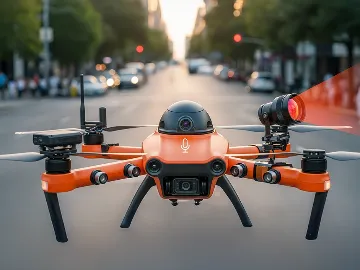Implementing computer vision (CV) involves more than just deploying software-it requires understanding your business processes and handling vast amounts of unstructured data. Additionally, it's essential to ensure that the solution scales effectively as your business grows.
With the right approach, a CV can transform your business's operations- all the way from automating tedious manual processes to uncovering insights that drive competitive advantage. With deep expertise in computer vision development services, N-iX understands the technical aspects of implementation-from designing custom advanced technical solutions to ensuring seamless integration with existing systems. In this article, we'll explore the key benefits of computer vision, address common challenges, and outline how a well-executed CV strategy can contribute to your long-term success.
How to make computer vision effective
The business goals of implementing computer vision are not just about achieving operational efficiency; they focus on driving strategic growth, fostering innovation, and gaining a competitive edge. Let's explore these goals further.
Elevating operational efficiency
According to McKinsey, companies that successfully implement AI-driven technologies, including computer vision, can reduce operational costs by up to 20% while increasing revenue by as much as 30% over the next decade. This potential for cost savings and boosted productivity makes computer vision an attractive option for your business.
The quest for operational excellence is at the core of any enterprise-doing more with less, faster, and with greater precision. However, the high-end goal is not just about refining processes; it's about turning operational efficiency into a strategic advantage. Computer vision enables enterprises to automate complex and previously manual processes, from manufacturing quality control to retail inventory management, thus optimizing performance and significantly reducing costs and errors.
Enhancing decision-making
Extracting actionable insights from vast amounts of visual data in real time can give enterprises a significant strategic advantage. However, the challenge lies not just in gathering this data but also in integrating it into the decision-making framework to enhance the speed, accuracy, and effectiveness of decisions at all levels of the organization.
Ensuring compliance
Compliance and risk management are the primary priorities for enterprises operating in heavily regulated industries. Computer vision can enhance these efforts. It provides automated monitoring and analysis capabilities that maintain compliance with regulatory standards and minimize risks in real time. The primary goal of computer vision implementation is to create a proactive compliance environment that meets regulatory standards and safeguards the enterprise from reputational and financial damage.
Maximizing ROI
Automation has long been a focus for enterprises seeking to reduce costs and increase efficiency. However, the next era of automation is about maximizing return on investment (ROI). Enterprises could achieve it strategically by implementing technologies like computer vision to optimize key business processes. The purpose is not just to automate for efficiency but to do so in a way that directly contributes to the bottom line.
The adoption of automation technologies has accelerated. 69% of business leaders have already implemented or plan to implement automation to enhance productivity. Computer vision technology that performs complex visual tasks is integral to this trend.
Read more: How to find a reliable computer vision development company?
Computer vision implementation best practices

Implementing computer vision involves a complex and multi-faceted process that demands a clear understanding of business objectives, high-quality data, appropriate hardware and software choices, and a strategic approach to model deployment. Drawing from N-iX's experience, this section takes a look into the essential components of a successful CV implementation.
1. Defining your strategic goals
The starting point of any successful computer vision project is clearly defining the business goals. Enterprises should address critical questions, such as: How can computer vision reduce operational costs? Can it help automate labor-intensive processes or improve customer experience? What is the potential return on investment? Additionally, the scalability must be considered during computer vision consulting services-will the technology grow with your business?
Our experience implementing computer vision solutions for various industries underscores the importance of this goal-setting phase. In a recent computer vision outssourcing project, the challenge was streamlining operations across hundreds of warehouses. When we clearly defined the business problem-improving inventory management through automation-we were able to design a computer vision system. We had not only addressed the immediate need for automation but also set the groundwork for future growth alongside the business.
2. Data acquisition and preparation
Data drives the success of any computer vision project. The precision and effectiveness of training models depend on the quality and scope of the data used. However, raw data is rarely ready for use straight away. Acquiring data involves gathering images, videos, or other visual inputs from various sources, ensuring they accurately represent the scenarios the model will face in real-world applications.
Once the data is collected, it needs to be cleaned and prepared for training. This process includes eliminating noise, correcting inconsistencies, and applying augmentation techniques to enhance the dataset's robustness. Preprocessing steps such as resizing, normalization, and augmentation are vital to preparing the data in the best format for learning. An effective data management strategy-including storage, retrieval, and processing-maintains the model's integrity and performance throughout its lifecycle. Without high-quality, well-prepared data, even the most advanced models can fall short.
At N-iX, we've gathered, cleaned, and managed different datasets for our clients. For instance, while developing an intelligent transport solution, we tackled the challenge of diverse environmental conditions affecting image quality. When preparing datasets for factors like sun glare, varied camera angles, and low-light conditions, we reached high detection accuracy for seatbelt fastening and distracted driving behaviors. As a result, our meticulous attention to data analytics and quality enables our CV systems to perform reliably in real-world conditions.
3. Choosing the proper hardware and software
The choice of hardware and software directly impacts the system's performance, scalability, and cost-effectiveness. The decision begins with selecting the appropriate hardware:
- GPUs are known for their parallel processing capabilities and training deep learning models requiring significant computational power.
- TPUs offer specialized acceleration for AI workloads for large-scale applications where speed and efficiency are important factors.
The project's conditions should guide the selection of hardware. For instance, computer vision use cases that require real-time processing, such as autonomous vehicles or real-time video analytics, may benefit from edge computing devices like Nvidia Jetson, which can process data locally with minimal latency. Conversely, cloud-based deployments may leverage cloud GPUs or TPUs through platforms like Google Cloud or AWS.
On the software side, development teams widely adopt frameworks like TensorFlow and PyTorch for building computer vision models. TensorFlow is often favored for production environments due to its robust deployment capabilities, while PyTorch is favored for its ease of use and flexibility in research settings.
In our collaboration with a company that provides intelligent transport solutions (ITS) for the government, we leveraged Nvidia Jetson devices and TensorFlow to build a real-time computer vision system. We achieved detection accuracy rates of 88% for seat belts and 91% for distracted driving. The need for a solution that quickly and accurately processes high-resolution images in real time drove hardware and software selection.
Read more: Increasing market reach with traffic management and computer vision
4. Model selection and training
The choice of model architecture depends on the project's specific problem, the nature of the data, and the available computational resources. For instance, convolutional neural networks (CNNs) are commonly used for image classification tasks. At the same time, more complex architectures like ResNet or YOLO might be necessary for object detection or real-time applications.
Training these models involves feeding them large amounts of labeled data and iteratively adjusting their parameters to minimize errors. This process, known as supervised learning, demands careful monitoring of the model's learning and generalizing well to new, unseen data. Cross-validation, data augmentation, and regularization improve the model's ability to generalize and avoid overfitting.
In our partnership with the Swiss smartwatch manufacturer, we employed a combination of OpenCV and custom algorithms to develop a model that could perform real-time UI testing. The training process was highly iterative, with continuous refinement based on performance metrics such as accuracy and latency. Using techniques like data augmentation and transfer learning, we achieved a model that was accurate and robust, capable of handling the diverse challenges of real-world deployment.
Explore more about the use cases of computer vision in sports
5. Deployment
Deployment is the final stage in the computer vision implementation process, where the trained model is integrated into the life environment. This stage entails careful planning for accurate model performance as expected under real-world conditions. The deployment strategy often relies on the application's nature and the available infrastructure.
There are various deployment options to consider, each with its strengths depending on the specific requirements of the project:
- On-premises deployments, such as industrial automation or surveillance systems, are often chosen for applications requiring low latency and high security. These deployments involve integrating the model with existing systems for compatibility and seamless operation.
- Cloud-based deployments offer greater flexibility and scalability, making them ideal for applications that process large data volumes across multiple locations.
- Edge computing is another deployment option suitable for real-time applications where processing must occur close to the data source. However, this edge computer vision requires careful consideration of hardware constraints, as these devices frequently have limited computational power.
Our experience across various industries has shown that whether the deployment is on-premises, cloud-based, or on the edge, the key is seamless integration. For instance, in modernizing the logistics platform, we deployed a cloud-native microservices architecture that enabled real-time package tracking across more than 400 warehouses. This deployment strategy allowed switching between cloud providers across a global network, optimizing performance and cost. We carefully consider data sensitivity, processing speed, and scalability for efficient CV solution deployment.
Master real-time precision with edge computer vision – get the practical guide!


Success!

Addressing the challenges of computer vision implementation
We recognize that successful computer vision implementation needs to address various technical, operational, and ethical issues. Our deep expertise and experience in the field allow us to anticipate and navigate these challenges effectively. Here's how we approach and manage the key challenges:
- Algorithm complexity and performance: We leverage advanced techniques such as model optimization and pruning to balance complexity with real-time performance. Even the most sophisticated algorithms operate efficiently in production environments.
- Hardware integration and optimization: We conduct thorough assessments to select the most suitable hardware configurations for seamless integration with existing infrastructure and optimal performance of CV applications.
- Integration with legacy systems: Our customized integration strategies enable new CV solutions to coexist harmoniously with legacy systems, preserving stability while introducing cutting-edge technologies.
- Addressing bias and fairness in CV algorithms: We implement rigorous testing and validation to mitigate biases in CV solutions that must be fair, ethical, and perform equitably across diverse scenarios.
- Handling large-scale image and video data: Our big data and cloud computing expertise allow us to design scalable data pipelines that efficiently manage vast amounts of visual data, supporting real-time analysis and decision-making.
Read also: Computer vision quality inspection: How AI improves accuracy and compliance
Wrapping up
The successful implementation of computer vision solutions demands a sophisticated blend of technical expertise, strategic planning, and industry-specific adaptation. N-iX has demonstrated its ability to navigate the intricate challenges of computer vision, from optimizing complex algorithms to ensuring seamless integration with existing infrastructures.
The journey to successful computer vision implementation is more than just a technical challenge - it's about understanding the unique needs and crafting proven solutions for enterprises. At N-iX, we've walked this path alongside our clients for over 23 years, tackling everything from complex algorithmic hurdles to integrating cutting-edge systems into established workflows.
Have a question?
Speak to an expert




